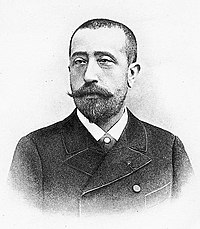
Photo from wikipedia
Objective. High frequency deep brain stimulation (DBS) of the subthalamic nucleus (STN) suppresses excessive beta band (∼13–30 Hz) activity of the motor cortex in Parkinson’s disease (PD). While the mechanisms… Click to show full abstract
Objective. High frequency deep brain stimulation (DBS) of the subthalamic nucleus (STN) suppresses excessive beta band (∼13–30 Hz) activity of the motor cortex in Parkinson’s disease (PD). While the mechanisms of action of STN DBS are not well-understood, strong evidence supports a role for cortical network modulating effects elicited by antidromic activation of cortical axons via the hyperdirect pathway. Approach. A spiking model of the thalamo-cortical microcircuit was developed to examine modulation of cortical network activity by antidromic STN DBS, mediated by direct activation of deep pyramidal neurons (PNs) and subsequent indirect activation of other thalamo-cortical structures. Main results. Increasing synaptic coupling strength from cortical granular to superficial layers, from inhibitory neurons to deep PNs, and from thalamus reticular to relay cells, along with thalamocortical connection strength, accompanied by reduced coupling from cortical superficial to granular layers, from thalamus relay cells to reticular neurons, and corticothalamic connection strength, led to increased beta activity and neural synchrony, as observed in PD. High frequency DBS desynchronized correlated neural activity, resulting in clusters of both excited and inhibited deep cortical PNs. The emergence of additional frequency components in the local field potential (LFP), and increased power at subharmonics of the DBS frequency as observed in patients with dyskinesia during DBS, occurred under different stimulus amplitudes and frequencies. While high-frequency (>100 Hz) DBS suppressed the LFP beta power, low-frequency (<40 Hz) DBS increased beta power when more than 10% of PNs were activated, but reduced the total beta power at lower levels of neural activation. Significance. The results suggest a potential mechanism for experimentally observed alterations in cortical neural activity during DBS via the propagation of DBS stimuli throughout the cortical network, modulated by short-term synaptic plasticity, and the emergence of resonance due to interaction of DBS with existing M1 rhythms by engaging feedforward-feedback loops.
Journal Title: Journal of Neural Engineering
Year Published: 2021
Link to full text (if available)
Share on Social Media: Sign Up to like & get
recommendations!